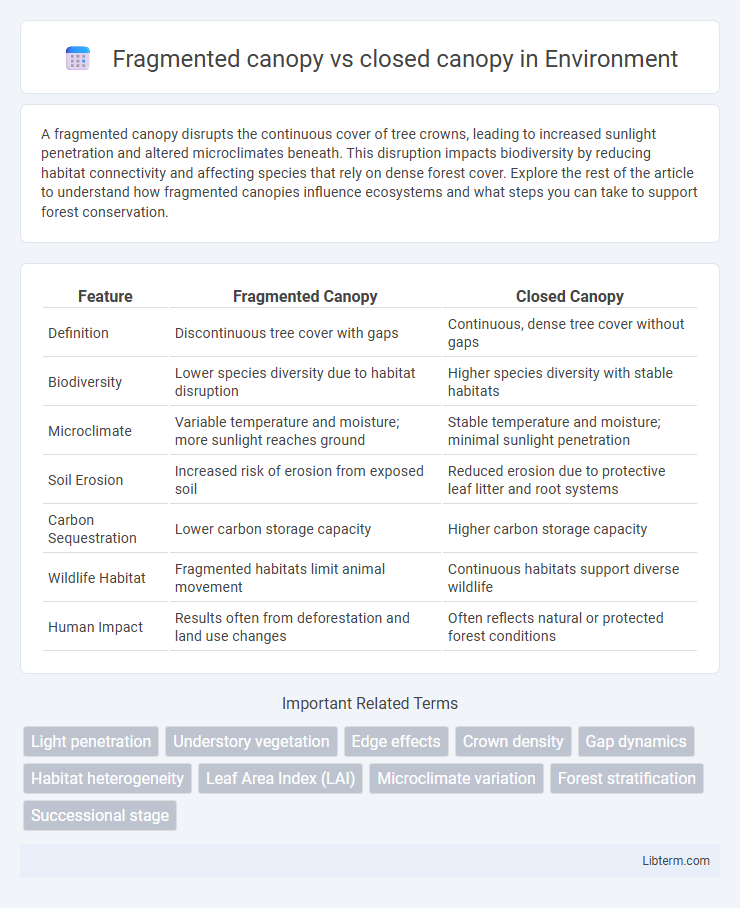A fragmented canopy disrupts the continuous cover of tree crowns, leading to increased sunlight penetration and altered microclimates beneath. This disruption impacts biodiversity by reducing habitat connectivity and affecting species that rely on dense forest cover. Explore the rest of the article to understand how fragmented canopies influence ecosystems and what steps you can take to support forest conservation.
Table of Comparison
| Feature | Fragmented Canopy | Closed Canopy |
|---|---|---|
| Definition | Discontinuous tree cover with gaps | Continuous, dense tree cover without gaps |
| Biodiversity | Lower species diversity due to habitat disruption | Higher species diversity with stable habitats |
| Microclimate | Variable temperature and moisture; more sunlight reaches ground | Stable temperature and moisture; minimal sunlight penetration |
| Soil Erosion | Increased risk of erosion from exposed soil | Reduced erosion due to protective leaf litter and root systems |
| Carbon Sequestration | Lower carbon storage capacity | Higher carbon storage capacity |
| Wildlife Habitat | Fragmented habitats limit animal movement | Continuous habitats support diverse wildlife |
| Human Impact | Results often from deforestation and land use changes | Often reflects natural or protected forest conditions |
Understanding Canopy Types: Fragmented vs Closed
Fragmented canopy refers to a forest structure where tree coverage is interrupted by gaps, leading to increased light penetration and microhabitat diversity, while closed canopy denotes a continuous, dense tree layer that limits sunlight to the forest floor, influencing undergrowth and biodiversity. Understanding these canopy types is crucial for ecological studies, as fragmented canopies support different species assemblages and ecological processes compared to closed canopies. Canopy fragmentation often results from natural disturbances or human activities, impacting carbon storage, wildlife corridors, and habitat quality.
Key Characteristics of Fragmented Canopy
Fragmented canopy refers to a forest structure where tree cover is interrupted by gaps caused by natural disturbances or human activities, leading to isolated patches of vegetation within a landscape. Key characteristics include reduced habitat continuity, increased edge effects influencing microclimate and species composition, and elevated vulnerability to invasive species and environmental stresses. These factors often result in lower biodiversity and altered ecosystem functions compared to closed canopy forests, where continuous tree cover supports more stable and diverse habitats.
Defining Features of Closed Canopy
Closed canopy forests are characterized by a continuous layer of tree crowns that cover more than 80% of the sky when viewed from the ground, creating a shaded environment with limited sunlight penetration. The dense foliage supports high humidity levels and stable microclimates, fostering diverse understory vegetation and rich biodiversity. These forests contrast with fragmented canopies, where gaps between tree crowns allow more light to reach the forest floor, affecting ecosystem dynamics and species composition.
Biodiversity Impacts of Canopy Structures
Fragmented canopy structures reduce habitat connectivity, leading to decreased species diversity and increased edge effects that threaten sensitive flora and fauna. Closed canopies maintain stable microclimates, promoting higher biodiversity by supporting shade-tolerant species and complex ecological interactions. Studies show closed canopies enhance ecosystem resilience and facilitate nutrient cycling, whereas fragmented canopies often result in habitat degradation and loss of endemic species.
Light Penetration: Fragmented vs Closed Canopy
Fragmented canopies allow significantly more light penetration to the understory, promoting greater plant biodiversity and enhancing seedling growth. In contrast, closed canopies create a dense layer of foliage that restricts light transmission, resulting in lower light availability and reduced understory vegetation. Light availability differences between fragmented and closed canopies influence microclimate, photosynthesis rates, and ecosystem productivity.
Effects on Understory Vegetation
Fragmented canopies create varied light environments, allowing increased sunlight to reach the forest floor and promoting greater species diversity in understory vegetation. Closed canopies limit light penetration, resulting in shaded conditions that favor shade-tolerant plants but reduce overall understory plant diversity. The contrast in light availability significantly influences seedling recruitment, growth rates, and species composition beneath the canopy.
Wildlife Habitat Differences
Fragmented canopies often result in increased edge effects, which alter microclimates and reduce habitat quality for interior forest species, leading to decreased biodiversity compared to closed canopies. Closed canopies provide continuous, stable environments with consistent light, temperature, and humidity levels critical for sensitive wildlife species, supporting higher species diversity and abundance. Wildlife dependent on connected forest habitats, such as certain birds, mammals, and amphibians, thrive in closed canopies, whereas fragmented canopies favor generalist or edge-tolerant species, affecting ecosystem dynamics and conservation priorities.
Canopy Structures and Microclimate Regulation
Fragmented canopy structures create heterogeneous light and temperature conditions, resulting in increased microclimate variability and reduced humidity regulation compared to closed canopies. Closed canopies provide continuous leaf cover that stabilizes microclimate by moderating temperature fluctuations, enhancing moisture retention, and reducing wind speed. These differences in canopy architecture significantly influence understory biodiversity, soil moisture dynamics, and ecosystem resilience.
Human Influence on Canopy Fragmentation
Human activities such as urban development, agriculture, and logging significantly contribute to canopy fragmentation by breaking continuous forest cover into isolated patches. This fragmentation disrupts habitat connectivity, alters microclimates, and negatively impacts biodiversity and ecosystem services. The extent of human-induced canopy fragmentation can be quantified using remote sensing data and GIS techniques to assess landscape changes over time.
Restoration Strategies for Canopy Integrity
Fragmented canopy areas disrupt habitat connectivity and microclimate stability, necessitating restoration strategies that prioritize reforestation with native species and strategic planting to reconnect isolated patches. Closed canopy forests support biodiversity by maintaining consistent light, moisture, and temperature regimes, making restoration efforts focus on preserving mature trees and preventing further fragmentation through controlled land use. Effective canopy restoration integrates spatial planning, continuous monitoring, and community involvement to enhance forest resilience and ecosystem services.
Fragmented canopy Infographic

 libterm.com
libterm.com